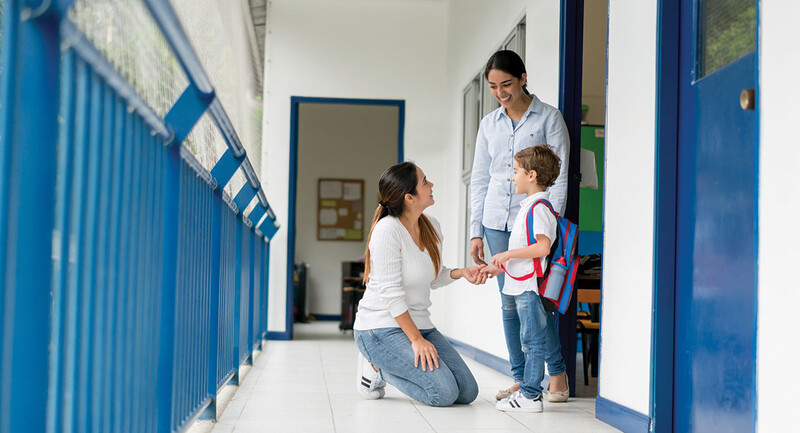For the past few years, seemingly every decision school leaders made was bound to be unpopular—be it masks or no masks, learning remotely or in-person, focusing on social-emotional learning or addressing learning losses. Certainly, being a school administrator has never been about winning a popularity contest, but as every leader knows, unhappy families can derail a school's best laid plans. So, what can school leaders do to build—and if necessary, restore—caregiver satisfaction with their schools?
A Mixed Picture
First, let's take stock of the current landscape. According to Gallup's latest survey of U.S. parents and adults, fully 73 percent remain somewhat or completely satisfied with the education their children are receiving (Brenan, 2021). The bad news is that caregivers have soured in their views of K–12 education overall—just 42 percent say they are somewhat or completely satisfied with U.S. schools, down from 59 percent three years ago.
These data were collected during the height of the pandemic and shift to online learning, so it's possible families' sentiments may have bounced back since then. Nonetheless, few enterprises can risk anemic customer satisfaction for long. For solutions, let's turn to the research.
Safety First
One universal priority for families is safe schools. The most recent Harris Interactive Poll of 27,000 U.S. parents found that while caregivers from different ethnic groups placed varied emphasis on things like parental involvement, technology, and the aesthetics of school grounds, children's physical and emotional safety was the number one driver of school satisfaction for all groups (Friedman et al., 2006).
That's noteworthy because according to the data, 20 percent of students ages 12–18 say they've been bullied at school, yet they report less than half of those incidents to adults in their schools (Wang et al., 2020). As a result, bullying can be a greater problem than school leaders realize and thus a hidden driver of parental dissatisfaction.
In coauthor Tonia's experience as a school administrator in Melbourne, Australia—where public, parochial, and private schools are all publicly funded, creating fierce competition for students and caregivers—she found that consistent use of schoolwide policies and practices for disruptive behavior, bullying, and other safety concerns, coupled with compassion and understanding for all parties involved, were key to reassuring families that their children attended safe schools.
Infractions had consequences but were also treated as teachable moments—opportunities for students to take ownership of their behaviors, recognize the need to control their emotions, and make better decisions. With this approach, a safe and orderly school environment became the shared responsibility of everyone in the school community.
Teacher Quality Second
Second to safety, families' perceptions of teaching quality drive how they rate their children's schools (Friedman et al., 2006)—and possibly for good reason. Studies show that students with highly effective teachers can gain up to 1.5 years of learning for each year in the classroom, while those with ineffective teachers often gain only six months of learning in that same time (Hanushek, 2002). Moreover, studies have long shown that stark differences in teacher quality commonly exist within the same school building (Konstantopoulos, 2005)—a fact caregivers hint at when they request particular teachers and avoid others.
Basically, leaders should be able to guarantee families that their children will have a good learning experience no matter who teaches them. Tonia found the only way she could make this guarantee was to be in classrooms every day, several times per day, to see which teachers modeled effective teacher practice (so she could point other teachers to them) and which teachers needed additional professional learning, observations, and coaching to ensure consistent, high-quality instruction across the school.
Freedom of Choice
Multiple studies show that caregivers who enroll their children in private or charter schools or whose children attend a non-assigned district school are significantly more satisfied than those whose children attend assigned district schools (Cheng & Peterson, 2017; Oberfield, 2020). One explanation for this may be that schools of choice have more resources or latitude to align programming with families' and students' needs (Cheng et al., 2017). Another possibility, though, may lie in what cognitive scientists call "choice-supportive bias"—that is, our natural tendency to rationalize our choices by accentuating the positive attributes of our selections and downplaying the attributes of the alternatives (Mather & Johnson, 2000).
In school settings, providing students meaningful educational choices—choices that are relevant to students' interests and goals, neither too numerous nor too complex, and aligned with their families' cultures and values—promotes student engagement and success.
Such choices can include extracurricular activities, electives, and clubs, as well as classroom-based opportunities to pursue individual interests through projects and other forms of independent learning. In the "free market" system of Melbourne, Tonia found that what typically mattered most to families was that their child wouldn't be shoe-horned into a one-size-fits-all model of education, but rather, caring adults would recognize and afford their child opportunities to develop their unique talents and interests.
Drivers of Satisfaction
It may be helpful to think of these drivers of satisfaction as a form of Maslow's (1962) hierarchy of needs: Safety first, followed by teachers who create a sense of belonging for students and families, followed by opportunities to achieve one's full potential.
The good news is that these drivers of satisfaction are also key correlates of school performance. School leaders need not bend over backwards to woo parents—they should focus on creating a great school that offers meaningful academic choices to students, high-quality instruction in every classroom, and a safe and supportive learning environment.









